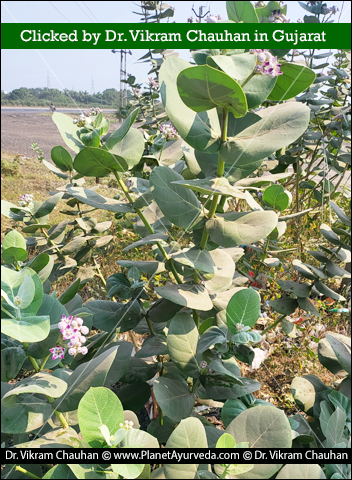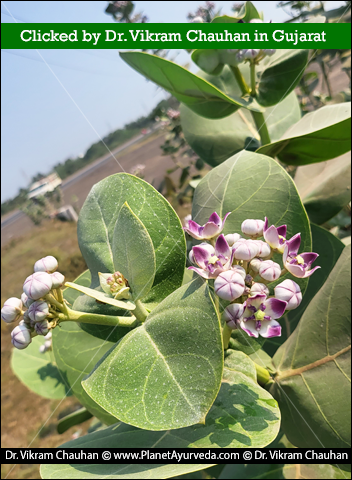Calotropis Procera (Madaar / Shwet Ark) and Rakta Arka – A Versatile Plant in Ayurveda with Medicinal Properties
Introduction
Calotropis procera, commonly known as “Akanda” or “Madar,” is a plant species that holds a prominent place in traditional Indian medicine, Ayurveda. This versatile plant thrives in arid and semi-arid habitats and is recognized for its numerous medicinal properties. In this article, we will explore the habitat, properties, and medicinal uses of Calotropis procera as per the principles of Ayurveda.

Classical Reference:- Bhavprakash nighantu – 291
Classical Categorization
As per Acharya Charak
- Bhedniye (Split the excreta into parts and expel it out from the body)
- Vamnopag (Induces vomiting)
- Swedopag (Induces sweating)
Sanskrit Synonyms
- Arka (Sharp and hot like Sun)
- Toolphal (Soft fruit like cotton)
- Ksheerparna (Milk in leaves)
- Vikirna (Due to air Fruit Spreads here and there)
- Asphota (As the fruit burst out)
Habitat
Calotropis procera is a hardy shrub that is native to several regions, including parts of Africa, the Middle East, and the Indian subcontinent. It is well adapted to arid and semi-arid environments and can be found in a range of habitats, including deserts, wastelands, and dry plains. In India, it is commonly seen in Rajasthan, Gujarat, and other states with similar climatic conditions.
The plant has evolved several mechanisms to survive in harsh environments. Its leaves and stems are covered with fine hairs, which help reduce water loss due to transpiration. The deep roots of Calotropis procera allow it to access groundwater, making it well-suited to drought-prone areas. These adaptations to its habitat are indicative of the plant’s resilience and have made it an essential component of traditional healing systems like Ayurveda.
Pharmacological Properties
- Ras (Taste) – Katu (Pungent), Tikta (Bitter)
- Guna (Physical property) – Laghu (Light), Ruksha (Dry), Teekshna (Sharp)
- Veerya (Potency) – Ushna (hot)
- Vipaka (Post digestion effect) – Katu (Pungent)
- Effect on dosha – Kapha vata shamak
Properties Of Calotropis Procera
Calotropis procera possesses various properties that make it valuable in Ayurveda. Here are some of the key properties of this plant:
- Bitter Taste (Tikta Rasa) – Calotropis procera is known for its bitter taste. In Ayurveda, the bitter taste is associated with qualities like detoxification and promoting digestion.
- Astringent (Kashaya Rasa) – The astringent taste in Calotropis procera helps in reducing excess moisture in the body and is often used to treat conditions related to mucus and excessive sweating.
- Light (Laghu) – The light property of this plant is considered beneficial for digestion and promoting the assimilation of nutrients in the body.
- Dry (Ruksha) – Its dryness is believed to help in managing conditions related to excessive moisture and dampness in the body.
- Katu Vipaka – The post-digestive effect of Calotropis procera is “Katu,” meaning it has a pungent effect on the body.
Medicinal Uses As Per Ayurveda
Calotropis procera has a long history of use in Ayurvedic medicine. Its various parts, including the roots, leaves, and latex, have been utilised for their therapeutic properties. Here are some of the medicinal uses of Calotropis procera as per Ayurveda:
- Treating Skin Disorders – The latex of Calotropis procera is known for its potent anti-inflammatory and antimicrobial properties. It is used topically to treat various skin disorders, including wounds, ulcers, and fungal infections.
- Digestive Disorders – The bitter and astringent properties of Calotropis procera make it useful in managing digestive disorders. It is used in formulations to alleviate conditions like diarrhea, dysentery, and abdominal pain.
- Respiratory Conditions – The plant’s properties help in reducing excessive mucus production, making it effective in managing respiratory conditions such as asthma and bronchitis.
- Analgesic Properties – Calotropis procera is used to relieve pain, especially in cases of arthritis and joint pain. It is often included in herbal formulations designed to alleviate musculoskeletal discomfort.
- Fever Management – In Ayurveda, Calotropis procera is used to manage fevers, particularly those associated with malaria and other infectious diseases.
- Wound Healing – The latex of the plant has wound-healing properties and is applied externally to promote the healing of cuts and abrasions.
- Anti-parasitic – Calotropis procera is known for its anthelmintic properties, making it effective in expelling intestinal worms.
- Anticancer Properties – Some studies have suggested that the plant may have potential anticancer properties, although further research is needed to confirm its efficacy.
- Swedajana (Induces sweating)
- Deepana (Appetizing)
- Pachan (Digestive)
- Pitta sravi (Excretes excessive Pitta)
- Kaphaghan (Pacifies kapha dosha)
- Vamak (Induces vomiting)
- Balya (Strengthening)
- Rasayan (Rejuvenator)
- Raktavikara (Bleeding disorders)
- Updansha (Syphilis – Sexually transmitted diseases)
- Sleepadh (Filariasis) – In this condition along with Arka, Ras Sindoor (Mercury based mineral formulation), Srotoanjana (Home made kajal prepared from smoke of lamp using castor oil), Kanji (fermented liquid preparation) and sambharseeng (Mrigshring) bhasma is used for local application to reduce the inflammation.
- In malaria its bark is given with Pan leaves to eat and in chronic fever its Phant (Herb-infused concoction)
- In chronic Rheumatoid arthritis Arkadi churn is given with Sontha churna to relieve pain and inflammation.
It is essential to note that while Calotropis procera has various medicinal uses, it should be used under the guidance of a qualified Ayurvedic practitioner. The dosage and method of administration can vary depending on the specific health condition and the individual’s constitution.
Part Used
- Moolatwak (Root bark)
- Ksheera (Milk obtained from leaves)
- Pushpa (Flower)
- Patra (Leaves)
Challenges And Precautions
Despite its many benefits, Calotropis procera is not without its challenges and precautions:
- Toxicity: The plant contains some toxic compounds, and excessive or improper use can lead to adverse effects. It should be used only under the supervision of an Ayurvedic expert as sometimes its use can cause diarrhoea.
- Allergic Reactions: Some individuals may be sensitive to the latex of Calotropis procera and may experience allergic reactions upon contact. It is crucial to perform a patch test before using it topically.
Dosage And Formulation
The dosage and formulation of Calotropis procera should be carefully prescribed, as it varies based on the individual’s health and constitution.
Medicinal Products Containing Arka
- Arka Lavan
- Arka Taila
- Arkeshwar Rasa
Conclusion
Calotropis procera is a plant with a rich history in traditional Ayurvedic medicine. Its habitat, properties, and medicinal uses make it a valuable resource for addressing a wide range of health conditions. However, its potent properties also necessitate caution and proper guidance in its usage. As with any herbal remedy, it is advisable to consult with a qualified Ayurvedic practitioner to receive the full benefits of Calotropis procera while ensuring safety and efficacy in its application. This plant stands as a testament to nature’s ability to provide solutions to the health challenges faced by humanity for centuries.





